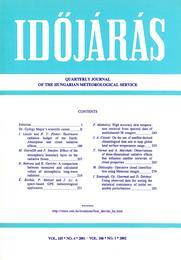Időjárás - Quarterly Journal of the Hungarian Meteorological Service (OMSZ)
Vol. 105, No. 4 * Pages 189–303 * October 2001 - March 2002 (Vol. 106, No.1)
 |
|
 download [pdf: 50416 KB]
download [pdf: 50416 KB]
Shortwave radiation budget of the Earth: Absorption and cloud radiative effects
László István, Pinker, R.T.
idojaras.2001.4.1 (p. 189–)
László István, Pinker, R.T.
idojaras.2001.4.1 (p. 189–)
Effect of the atmospheric boundary layer on the radiative fluxes
Ostrozlik, M., Smolen, F.
idojaras.2001.4.2 (p. 207–)
Ostrozlik, M., Smolen, F.
idojaras.2001.4.2 (p. 207–)
A comparison between measured and calculated values of atmospheric long-wave radiation
Behrens, K., Gericke, K.
idojaras.2001.4.3 (p. 219–)
Behrens, K., Gericke, K.
idojaras.2001.4.3 (p. 219–)
A space-based GPS meteorological application
Borbás Éva, Menzel, P., Li, J.
idojaras.2001.4.4 (p. 231–)
Borbás Éva, Menzel, P., Li, J.
idojaras.2001.4.4 (p. 231–)
High accuracy skin temperature retrieval from spectral data of multichannel IR imagers
Miskolczi Ferenc
idojaras.2001.4.5 (p. 243–)
Miskolczi Ferenc
idojaras.2001.4.5 (p. 243–)
On the use of satellite-derived climatological data sets to map global land surface temperature range
Csiszár Iván
idojaras.2001.4.6 (p. 253–)
Csiszár Iván
idojaras.2001.4.6 (p. 253–)
Observations of three-dimensional radiative effects that in-fluence satellite retrievals of cloud properties
Várnai Tamás, Mashak, A.
idojaras.2001.4.7 (p. 265–)
Várnai Tamás, Mashak, A.
idojaras.2001.4.7 (p. 265–)
Operative cloud classification using Meteosat images
Diószeghy Márta
idojaras.2001.4.8 (p. 279–)
Diószeghy Márta
idojaras.2001.4.8 (p. 279–)
Using observed data for testing the statistical consistency of initial ensemble perturbations
Szunyogh István, Gyarmati Györgyi, Dévényi Dezső
idojaras.2001.4.9 (p. 293–)
Szunyogh István, Gyarmati Györgyi, Dévényi Dezső
idojaras.2001.4.9 (p. 293–)
IDŐJÁRÁS - Quarterly Journal

Az IDŐJÁRÁS a HungaroMet Nonprofit Zrt. negyedévenként megjelenő angol nyelvű folyóirata
Megrendelhető a journal.idojaras@met.hu címen.
A szerzőknek szánt útmutató itt olvasható.
Megrendelhető a journal.idojaras@met.hu címen.
A szerzőknek szánt útmutató itt olvasható.









